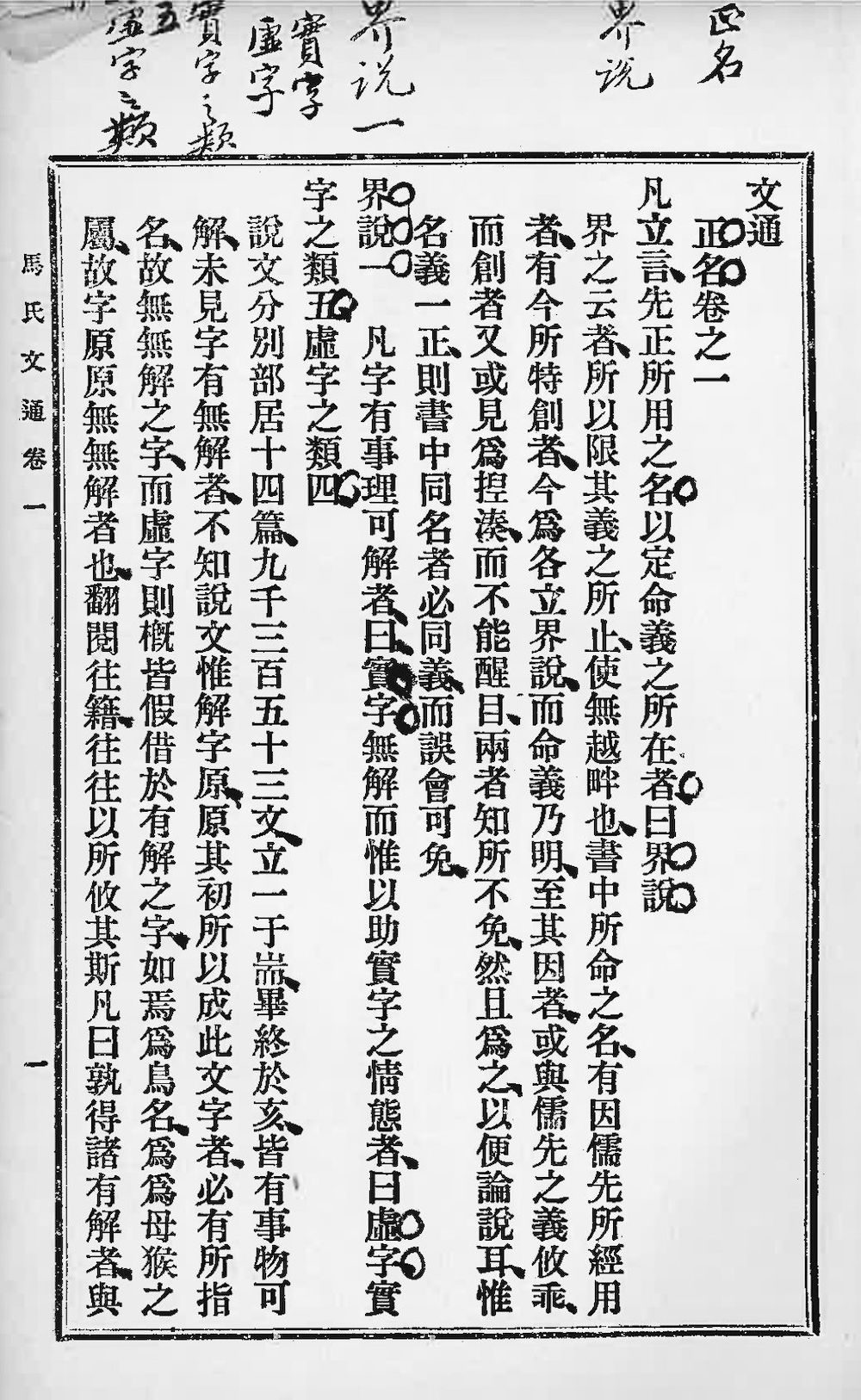Oct 14, 2010 © Ulrich Theobald
Mashi wentong 馬氏文通 "Master Ma's linguistic overview" is the oldest Chinese grammar. It was compiled by Ma Jianzhong 馬建忠 (1845-1900) and was published in 1898 by the Shanghai Commercial Press (Shanghai Shangwu Yinshuguan 上海商務印書館). In 1904, a punctuated edition was published by Zhang Xichen 章錫琛 (1889-1969) which was reproduced in 1954 by the Zhonghua Shuju Press 中華書局 and in 1983 by the Commercial Press. Lü Shuxiang 呂叔湘 (1904-1998) and Wang Haifen 王海棻 (1937-2019) compiled a textbook to the Mashi wentong, published in 1986.
Figure 1. Beginning of the Mashi wentong 馬氏文通
 |
First text page of the punctuated 1904(?) edition of the Shanghai Commercial Press, with marginalia and marks by the owner. Copy owned by the Asia-Oriental Institute, Tübingen, Germany. |
The Mashi wentong is a grammar for classical Chinese. It is enriched with several thousand examples from ancient literature, including the Confucian Classics, official dynastic histories, and writings of the famous Tang-period 唐 (618-907) scholar Han Yu 韓愈 (768-824). Its grammatical concept follows structures and terms used in Western grammars and tries to adapt those to the very different grammar of Chinese.
The 10-juan long book explains grammatical terms (which are often different to modern terms, like yuci 語詞 instead of weiyu 謂語 "verb" or jingzi 靜字 instead of xingrongci 形容詞 "adjective") and the grammar of Classical Chinese with the help of parts of speech or word functions, less from the aspect of syntax. The syntax is treated in the last fascicle.
Table 1. Examples of linguistic terminology used in the Mashi wentong 馬氏文通
| Mashi wentong |
Western correspondant |
modern term |
| word classes |
| 名字 |
noun |
名詞 |
| measure word |
量詞 |
| 代字 |
pronoun |
代詞 |
| 靜字 |
adjective |
形容詞 |
| determiner |
區別詞 |
| numeral |
數詞 |
| 動字 |
verb |
動詞 |
| 狀字 |
adverb |
副詞 |
| stative verbs |
狀態詞 |
| 介字 |
preposition |
介詞 |
| 連字 |
conjunction |
連詞 |
| 助字 |
particle |
助詞, 語氣詞 |
| 嘆字 |
interjection |
感嘆詞 |
| Syntactical functions |
| 詞起 |
subject |
主語 |
| 止詞 |
object |
賓語 |
| 轉詞 |
complement |
補語 |
| 表詞 |
predicate |
謂語 |
Schmidt 2018: xv-xvi (Table 2) and Nie 2007: 45. |
Sources:
Bai, Limin (2012). "Creating 'Real Learning' for China's Survival: Liang Qichao and the Ma Brothers, 1896-1898", Twentieth-Century China, 37/2: 101-120.
Deng Wenbin 鄧文彬 (2006). "Ma Jianzhong Mashi wentong yufa tixi shuping 馬建忠《馬氏文通》語法體系述評", Xinan Minzu Daxue xuebao (Renwen sheke ban ) 西南民族大學學報(人文社科版), 2006 (11).
Guo Qinna 郭芹納 et al., ed (1990). Jianming gu Hanyu zhishi cidian 簡明古漢語知識辭典 (Xi'an: Shaanxi renmin chubanshe), 122.
Li Kai 李開 (2018). "Hanwen jingwei [Gabelenz' Chinesische Grammatik] yu Mashi wentong bijiao yanjiu 《漢文經緯》與《馬氏文通》比較研究", Dangdai yuyanxue 當代語言學, 2018 (7).
Liu Yonggeng 劉永耕 (1996). "Mashi wentong dui Hanyu cilei yanjiu de gongxian 《馬氏文通》對漢語詞類研究的貢獻", Fujian Shifan Daxue xuebao (Zhexue shehui kexue ban) 福建師範大學學報(哲學社會科學版), 1996 (1).
Liu Yonggeng 劉永耕 (1998). "Mashi wentong de zhuangzi he zhuangci, zhuangyu, zhuanci, jiaci, zhuangdu 《馬氏文通》的“狀字”和“狀詞”、“狀語”、“轉詞”、“加詞”、“狀讀”", Fujian Shifan Daxue xuebao (Zhexue shehui kexue ban) 福建師範大學學報(哲學社會科學版), 1998 (7).
Mair, Victor H. (1997). "Ma Jianzhong and the Invention of Chinese Grammar," in Chaofen Sun, ed. Studies on the History of Chinese Syntax, Monograph Series Number 10 of Journal of Chinese Linguistics, 5-26.
Nie Zhiping 聶志平 (2007). "Mashi wentong de cileiguan 《馬氏文通》的詞類觀", Ningxia Daxue xuebao (Renwen shehui kexue ban) 寧夏大學學報(人文社會科學版), 2007 (11).
Peyraube, Alain (2001). "Some Reflections on the Sources of the Mashi wentong", in Michael Lackner, Iwo Amelung, Joachim Kurtz, eds. New Terms for New Ideas: Western Knowledge and Lexical Change in Late Imperial China (Leiden/Boston: Brill), 341-355.
Shao Longqing 邵龍青 (1993). "Mashi wentong 馬氏文通", in Shi Quanchang 石泉長, ed. Zhonghua guocui da cidian 中華百科要覽 (Shenyang: Liaoning renmin chubanshe), 663.
Schmidt, Muhammad Wolfgang G. A. (2018). Mister Ma's Grammar Guide to Literary Chinese: The Original Chinese Text of the Mashi Wentong with Chinese-English Character and Word Glossaries (Hamburg: Disserta).
Sun Fenghua 孫風華 (2002). "Ye tan Mashi wentong de zi wu ding lei 也談《馬氏文通》的“字無定類”", Gu Hanyu yanjiu 古漢語研究, 2002 (3).
Wang Dachang 汪大昌 (1993). "Mashi wentong 馬氏文通", in Ru Xin 汝信, ed. Shijie baike zhuzuo cidian 世界百科著作辭典 (Beijing: Zhongguo gongren chubanshe), 337.
Wang Haifen 王海棻 (1998). "Mashi wentong yanjiu bainian zongshuo 《馬氏文通》研究百年綜說", Zhongguo yuwen 中國語文, 1998 (9).
Wang Jianjun 王建軍 (2001). "Mashi wentong zhi qian de Qingdai xuci yanjiu 《馬氏文通》之前的清代虛詞研究", Gu Hanyu yanjiu 古漢語研究, 2001 (3).
Wang Yuguang 王余光, Xu Yan 徐雁, ed. (1999). Zhongguo dushu da cidian 中國讀書大辭典 (Nanjing: Nanjing daxue chubanshe), 1237.
Wu Feng 吳楓, ed. (1987). Jianming Zhongguo guji cidian 簡明中國古籍辭典 (Changchun: Jilin wenshi chubanshe), 66.
Yi Lin 易林 (1992). "Mashi wentong 馬氏文通", in Zhou Gucheng 周谷城, ed. Zhongguo xueshu mingzhu tiyao 中國學術名著提要, Vol. Yuyan wenzi 語言文字卷 (Shanghai: Fudan daxue chubanshe), 421.
Zádrapa, Lukáš (2006). "Mashi wentong: prvnl činská gramatika v kontextu doby", Studia Orientalia Slovaca, 5: 195-217.
Zhang Bin 張斌 (1988). "Mashi wentong 馬氏文通", in Zhongguo da baike quanshu 中國大百科全書, Yuyan wenzi 語言•文字 (Beijing/Shanghai: Zhongguo da baike quanshu chubanshe), 273.
